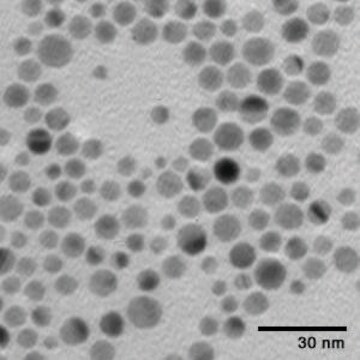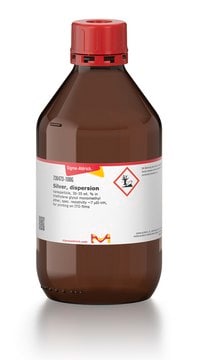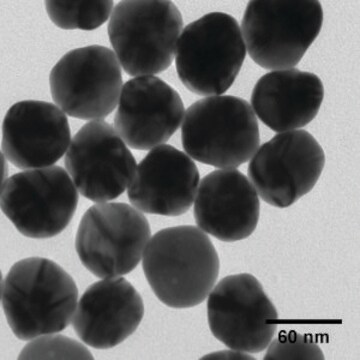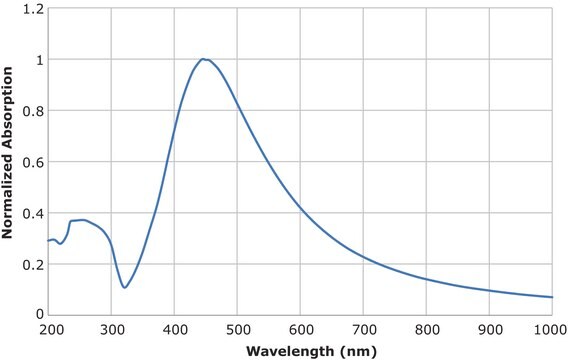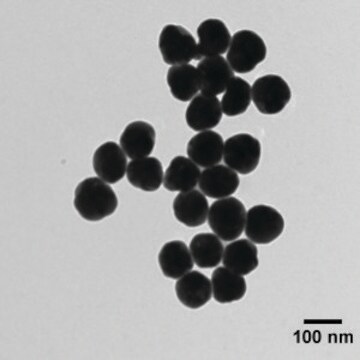736465
Silver, dispersion
nanoparticle, 30-35 wt. % in triethylene glycol monoethyl ether, spec. resistivity 11 μΩ-cm, for printing on plastic films
Sinonimo/i:
Silverjet DGP-40LT-15C, silver ink
About This Item
Prodotti consigliati
Livello qualitativo
Descrizione
surface tension 35 - 40 dyn/cm
Forma fisica
dispersion
nanoparticle
Concentrazione
30-35 wt. % in triethylene glycol monoethyl ether
Indice di rifrazione
n20/D 1.333
Dimensione particelle
≤50 nm
Viscosità
10-18 cP
Densità
1.45 g/mL±0.05 g/mL at 25 °C
Temperatura di conservazione
2-8°C
Stringa SMILE
[Ag]
InChI
1S/Ag
BQCADISMDOOEFD-UHFFFAOYSA-N
Cerchi prodotti simili? Visita Guida al confronto tra prodotti
Descrizione generale
Curing Temperature: 100-150 °C
Recommended substrates: Plastic films
Recommended washing solvent: Polar Solvents: Ethyl Alcohol, IPA etc.
Applicazioni
- Enhanced Adsorption of Trace Ethylene on Ag/NZ5 Modified with Ammonia: Hierarchical Structure and Metal Dispersion Effects.: This study examines the effects of hierarchical structure and metal dispersion in enhancing the adsorption of trace ethylene using silver/nanozeolite 5 modified with ammonia, exploring potential industrial applications for improved air quality and storage conditions (Qi et al., 2024).
- Structure-Activity Relationships between the State of Silver on Different Supports and Their I(2) and CH(3)I Adsorption Properties.: The paper details the correlation between the physical state of silver dispersed on various supports and its properties in adsorbing iodine and methyl iodide, which could be crucial for developing better filtration and purification systems (Azambre et al., 2021).
- New Relevant Descriptor of Linear QNAR Models for Toxicity Assessment of Silver Nanoparticles.: This publication introduces a new quantitative nanostructure-activity relationship (QNAR) descriptor that enhances the toxicity assessment of silver nanoparticles, significant for pharmaceutical applications where safety is paramount (Kudrinskiy et al., 2020).
- Resolving the puzzle of single-atom silver dispersion on nanosized γ-Al(2)O(3) surface for high catalytic performance.: Investigates the single-atom dispersion of silver on nano-sized γ-alumina surfaces, providing insights into optimizing the catalytic efficiency and potential applications in various chemical industries (Wang et al., 2020).
Risultati analitici
Note legali
Avvertenze
Warning
Indicazioni di pericolo
Consigli di prudenza
Classi di pericolo
Aquatic Acute 1 - Aquatic Chronic 1
Codice della classe di stoccaggio
10 - Combustible liquids
Classe di pericolosità dell'acqua (WGK)
WGK 3
Punto d’infiammabilità (°F)
Not applicable
Punto d’infiammabilità (°C)
Not applicable
Scegli una delle versioni più recenti:
Possiedi già questo prodotto?
I documenti relativi ai prodotti acquistati recentemente sono disponibili nell’Archivio dei documenti.
I clienti hanno visto anche
Articoli
Inkjet Printing for Printed Electronics
The ability to pattern conductive electrodes is technologically relevant for several applications, including photovolatics, displays, sensors, and biomedical devices.
The emerging field of printed electronics requires a suite of functional materials for applications including flexible and large-area displays, radio frequency identification tags, portable energy harvesting and storage, biomedical and environmental sensor arrays,5,6 and logic circuits.
Recent progress in the area of solution-processed functional materials has led to the development of a variety of thin-film optoelectronic devices with significant promise in the industrial and consumer electronics fields.
Il team dei nostri ricercatori vanta grande esperienza in tutte le aree della ricerca quali Life Science, scienza dei materiali, sintesi chimica, cromatografia, discipline analitiche, ecc..
Contatta l'Assistenza Tecnica.